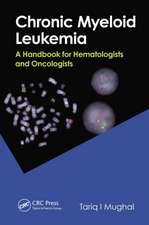Targeted Cancer Immune Therapy
Editat de Joseph Lustgarten, Yan Cui, Shulin Lien Limba Engleză Paperback – 22 aug 2016
| Toate formatele și edițiile | Preț | Express |
|---|---|---|
| Paperback (1) | 1412.99 lei 6-8 săpt. | |
| Springer – 22 aug 2016 | 1412.99 lei 6-8 săpt. | |
| Hardback (1) | 1321.76 lei 38-44 zile | |
| Springer – 23 aug 2009 | 1321.76 lei 38-44 zile |
Preț: 1412.99 lei
Preț vechi: 1487.36 lei
-5% Nou
Puncte Express: 2119
Preț estimativ în valută:
270.41€ • 281.27$ • 223.24£
270.41€ • 281.27$ • 223.24£
Carte tipărită la comandă
Livrare economică 14-28 aprilie
Preluare comenzi: 021 569.72.76
Specificații
ISBN-13: 9781493939916
ISBN-10: 1493939912
Pagini: 343
Ilustrații: XI, 343 p.
Dimensiuni: 155 x 235 x 19 mm
Greutate: 0.5 kg
Ediția:Softcover reprint of the original 1st ed. 2009
Editura: Springer
Colecția Springer
Locul publicării:New York, NY, United States
ISBN-10: 1493939912
Pagini: 343
Ilustrații: XI, 343 p.
Dimensiuni: 155 x 235 x 19 mm
Greutate: 0.5 kg
Ediția:Softcover reprint of the original 1st ed. 2009
Editura: Springer
Colecția Springer
Locul publicării:New York, NY, United States
Descriere
Stimulation of the immune system’s ability to control and destroy tumors cont- ues to be the goal of cancer immune therapy; but the scope has rapidly expanded; approaches are constantly updated; new molecules are continually introduced; and immune mechanisms are becoming better understood. This book has no intention of covering every aspect of immune therapy but rather focuses on the novelty of cancer immune therapy in an attempt to give readers an opportunity to absorb the new aspects of immune therapy from a single source. In this regard, three areas were selected: cytokine immune therapy, cell-based immune therapy, and targeted immune therapy. In each of these three sections, only the novel aspects of immune therapy were described instead of attempting to cover any historical achievement. In the first section, Cytokine Immune Therapy, the IL12 family, IL18, IL21, IL24, IL28, and IL29 were emphasized in regard to the an- tumor function and application in treating tumors. Most of these selected cyt- ines were discovered in last 10 years. In the second section, Cell-based Immune Therapy, the focus was engineering potent immune regulatory or effector cells such as dendritic cells, T cells, and stem cells. Cell engineering design is primarily based on the increased understanding of the interaction of tumor antigen-presenting cells, antigen- specific effector cells, and the tumor microenvironment.
Cuprins
Role of IL12 Family in Regulation of Antitumor Immune Response.- IL-18 in Regulation of Antitumor Immune Response and Clinical Application.- Interleukin-21 and Cancer Therapy.- IL-24 in Regulation of Antitumor Immune Response and in Signaling.- IL-28 and IL-29 in Regulation of Antitumor Immune Response and Induction of Tumor Regression.- Passive and Active Tumor Homing Cytokin Therapy.- New Strategies to Improve Tumor Cell Vaccine Therapy.- Modification of Dendritic Cells to Enhance Cancer Vaccine Potency.- Dendritic Cell Vaccines for Immunotherapy of Cancer: Challenges in Clinical Trials.- A Toll Bridge for T-Cells.- Engineering Adult Stem Cells for Cancer Immunotherapy.- Animal Models for Evaluating Immune Responses of Human Effector Cells in Vivo.- CD40 Stimulation and Antitumor Effects.- Immunocytokines: A Novel Approach to Cancer Immune Therapy.- Immune Escape: Role of Ondoleamine 2,3-Dioxygenase in Tumor Tolerance.- Adoptive Transfer of T-Bodies: Towards an Effective Cancer Immunotherapy.- Targeting Toll Like Receptor for the Induction of Immune and Antitumor Responses.- Manipulating TNF Receptors to Enhance Tumor Immunity for the Treatment of Cancer.-
Textul de pe ultima copertă
Cancer has surpassed heart disease as the number one killer in the world, and standard cancer therapy such as radiation, chemotherapy, and surgery may have reached its plateau in further improving the outcome of treated patients. Biological therapies combined with other treatment approaches may be the next X-factor to greatly extend survival time and improve patients’ quality of life. One of the most developed fields in biological therapy is immune therapy, which has stemmed into many branches due to its significance and the tremendous effort by a large population of scientists. Tumor-targeted antibody therapy has been successfully used for treating some types of tumors, and the first tumor vaccine against ovarian cancer has been developed for clinical application.
Targeted Cancer Immune Therapy provides comprehensive coverage of novel immune therapeutic approaches, including cytokine therapy, engineered cell therapy, and the application of tumor-targeted antibodies for generating tumor-specific cell therapy, TLR ligand therapy, and cytokine therapy. In the section "Cytokine Immune Therapy," the authors review relatively new cytokine family members, such as the IL12 family, IL18, IL21, IL24, IL28, and IL29, in regard to the anti-tumor function and application in treating tumors. The strategy for targeting and retaining cytokines in the tumor microenvironment is also reviewed. The section "Cell-based Immune Therapy" focuses on reviewing "state of the art" approaches for engineering potent immune regulatory or effector cells, such as dendritic cells, T cells, and stem cells, for tumor targeting and initiation of tumor specific immune response. In the section "Targeted Immune Therapy," the authors rearticulate antibody therapy for boosting immune response, which includes immunocytokines, "T-body," and tumor targeted CpG ODN. Some or all of these innovative approaches may ultimately become effective future immune therapies for treating malignancy.
Targeted Cancer Immune Therapy provides comprehensive coverage of novel immune therapeutic approaches, including cytokine therapy, engineered cell therapy, and the application of tumor-targeted antibodies for generating tumor-specific cell therapy, TLR ligand therapy, and cytokine therapy. In the section "Cytokine Immune Therapy," the authors review relatively new cytokine family members, such as the IL12 family, IL18, IL21, IL24, IL28, and IL29, in regard to the anti-tumor function and application in treating tumors. The strategy for targeting and retaining cytokines in the tumor microenvironment is also reviewed. The section "Cell-based Immune Therapy" focuses on reviewing "state of the art" approaches for engineering potent immune regulatory or effector cells, such as dendritic cells, T cells, and stem cells, for tumor targeting and initiation of tumor specific immune response. In the section "Targeted Immune Therapy," the authors rearticulate antibody therapy for boosting immune response, which includes immunocytokines, "T-body," and tumor targeted CpG ODN. Some or all of these innovative approaches may ultimately become effective future immune therapies for treating malignancy.














